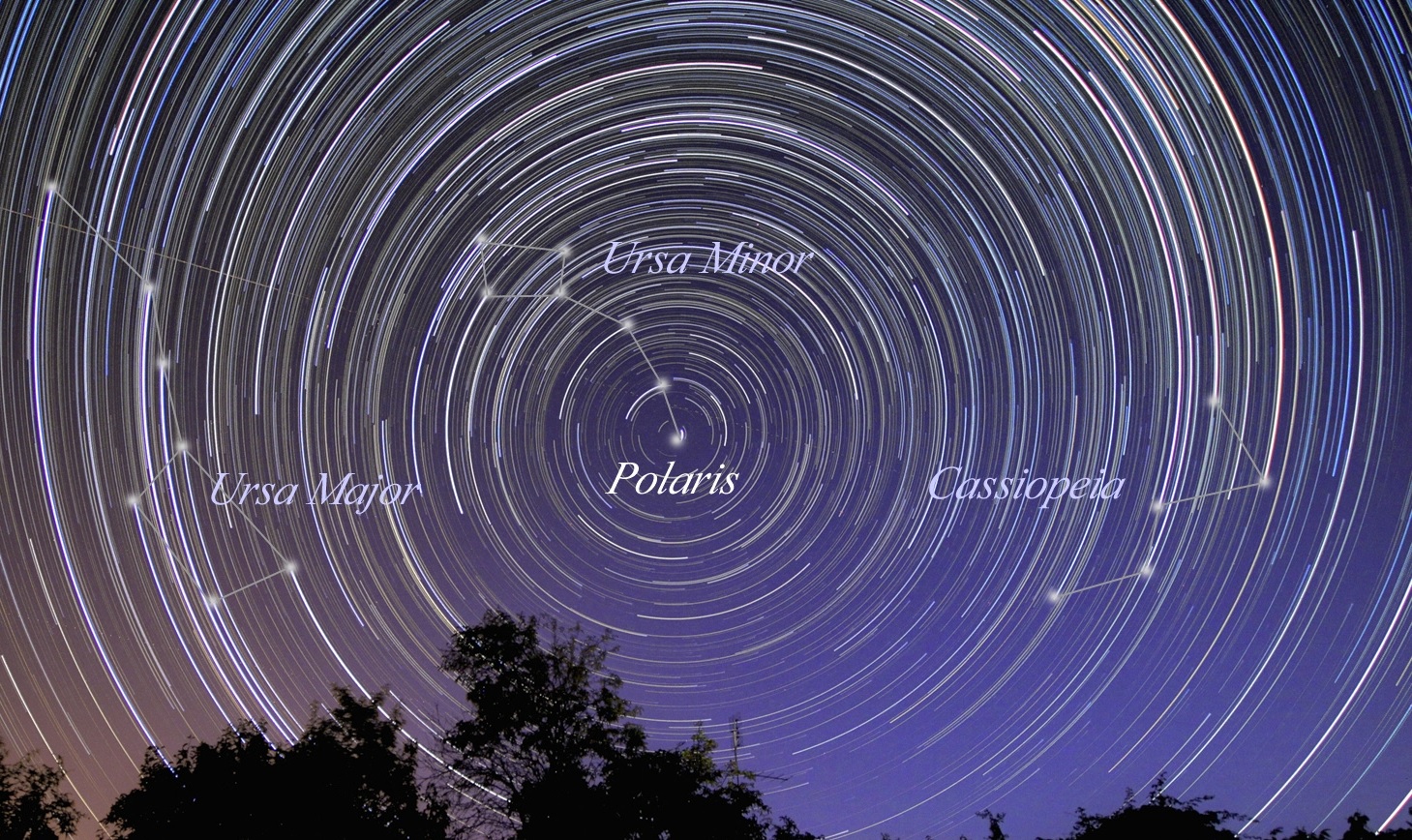Polaris. The guide star. The North Star.
It is the brightest star in the constellation Ursa Minor (Umi), and it therefore earns the first letter in the Greek: α Ursae Minoris.
Every sailor with a sextant knows how to find it – and how to determine their latitude and heading. Every soul on the Underground Railroad knew that Polaris would guide them to liberty. Every soldier, every traveler, and every scout worth their salt… they all know about the North Star.
Ursa Minor is Latin for ‘little bear’. Most Americans call it ‘the Little Dipper’ (and they also know Ursa Major as the ‘Big Dipper’). But throughout the ancient world these constellations were recognized as bears, and Polaris is at the tip of the little one’s tail. Yes, it is true that bears no longer have tails. Some cultures imagine the stars in the tail as hunters chasing the bear, and others have tales about how bear lost his tail.
Polaris has been used for centuries to navigate the northern hemisphere. But in the time of the Roman empire, β Ursae Minoris (also known as Kochab), was actually closer to the celestial pole. The earth’s rotational axis precesses, and the celestial pole traces a circle through different constellations every 25,800 years. In the more ancient world of the Egyptian dynasties, the pole star was the faint light of Thuban in the constellation Draco. However, in the modern era, Polaris will reach its closest approach to celestial north in the year 2100 CE, and will serve as the North Star for the remainder of the third millennium.
Polaris and Kochab are often used to align and calibrate telescope mounts to track the sky’s rotation, for long photographic exposures or extended observation of a particular object. Without such a tracking system, a long exposure photograph of the night sky can make a striking impression that shows the majesty of the celestial dance. Perhaps Vincent Van Gogh was inspired by such images when he painted The Starry Night.
To the naked eye, Polaris appears to be a single bright star; actually it is a multi-star system, about 430 light years, more or less due north from the North Pole. Polaris A, a class F7 yellow super giant, is the biggest and brightest star in the system. It has a mass four and a half times that of our own sun; and its diameter is fifty times larger. The photo-sphere is roughly the same temperature as our own sun, but since it is the skin on a ball 50 times bigger, the surface area is almost 2500 times larger – and therefore it is 2500 times brighter than our sun.
In 1780 William Herschel observed that there was a companion star, Polaris B. He did so with a reflecting telescope that he built by hand, and we’ve subsequently learned that Polaris B is a main sequence star, much like our own sun. But it is 1.4 times the mass, and it orbits the Polaris A every 42,000 years, at distance of about 2400 AU. As a reminder, an astronomical unit, or AU, is the average distance between the earth and the sun (about 150 million kilometers). For comparison: Pluto orbits the sun at a distance of around 40AU; so Polaris B orbits the big Polaris A at a distance 60 times greater than the size of our own solar system.
In the mid -1920’s, Moore and Kholodovsky analyzed spectral observations of the system, and suggested that there is another, closer companion star. Subsequent studies confirmed this theory, and we now know that Polaris Ab is also a main sequence star (about 1.26 times the mass of the sun), which orbits Polaris A at a distance of around 18.8 AU. That’s similar to the orbit of Uranus. In 2006, the Hubble telescope was actually able to image Polaris Ab next to Polaris A. That’s a remarkable achievement considering the great distance to the system, and the immense luminosity of the yellow supergiant compared to the M class star so close to it.
There is some speculation that there might actually be a Polaris C, and even Polaris D, in this already complicated star system. But the data may be better explained by perturbations from neighboring systems. When you consider the scale of the Polaris star system, you can imagine that it is difficult to measure and infer the characteristics of such a distant, enormous, and ponderous star system.
Polaris A, the yellow supergiant, also happens to be a Cepheid variable star, meaning that instabilities in its stellar dynamics produce periodic variations in luminosity… it flickers slightly. That is interesting because such stars are used as a ‘standard candle’ by astronomers, in order to estimate distances and develop a map of our galaxy (and galactic neighbors). In fact, Polaris is the closest Cepheid variable star to earth. So it is notable that the star which we use to navigate, is also the closest example of the type that we use to map out our galaxy. Polaris truly is the guide star.
Could there be planets, asteroids, comets, or even alien life forms from Polaris? We don’t yet know the answer to that question, because our exoplanetary detection and study techniques are mostly applicable to planets closer to our solar system. But we have identified exoplanets over 13000 light years away; and we have observed a system with a planet orbiting at over 6900AU from its star! In such rich tapestry, who knows? Maybe there are planets, and even life, at Polaris. Given the layout, it would be best to look around Polaris B.
As our space-based telescopes improve and our astronomers learn more about exoplanets, we may yet learn other fascinating details about this wondrous star system. But even if we manage to travel there someday, α Ursae Minoris will remain mysterious as an example of cosmic coincidence, and inspiration for those that suspect our species’ evolution is guided.
